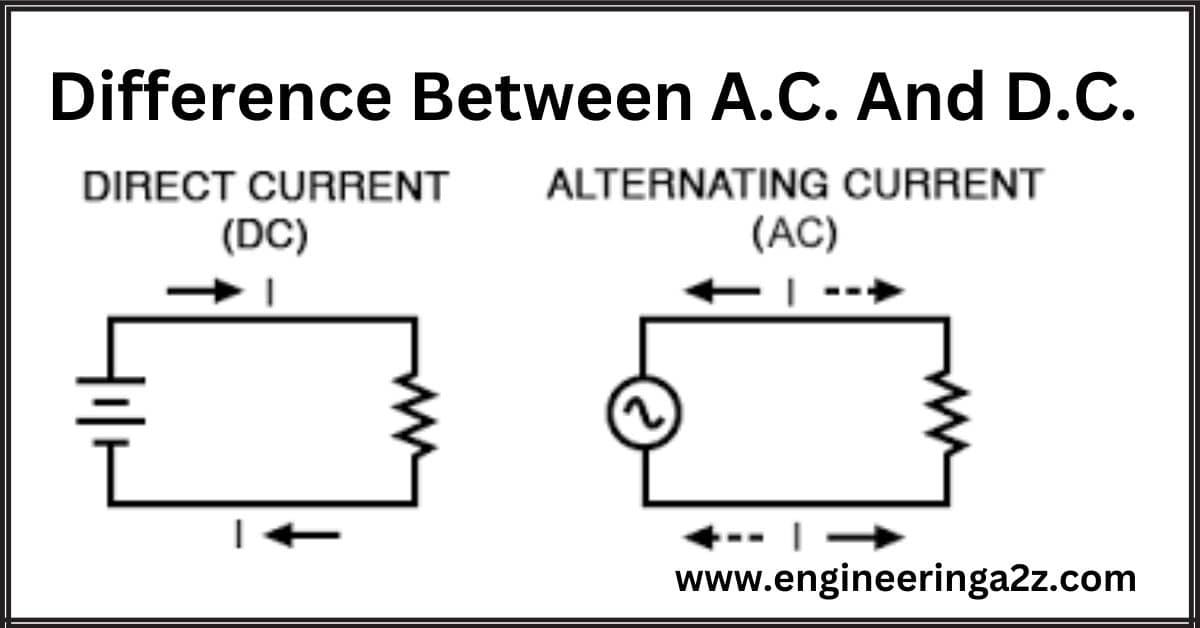
Table of Contents
Alternating Current (A.C.)
In alternating current, the electric charge flow changes its direction periodically. The most popular and widely utilized form of electric power for buildings, offices, and other places of use is alternating current (AC). It was initially put to the test in 1832 utilizing a dynamo-electric generator and Michael Faraday’s theories.
A sine wave is a waveform that indicates alternating electricity. It can be described as a curved line in other words. These curved lines, which are measured in seconds per cycle, depict electric cycles. The unit of measurement is Hertz (Hz). Because it is relatively simple to produce and transport AC over long distances, AC is used in power plants and buildings. Electric motors used in appliances like refrigerators and washing machines can be powered by AC.
Direct Current (D.C.)
Unlike alternating currents, the flow of direct currents does not change periodically. Electricity is flowing at a constant voltage in a single direction. DC is mostly used to charge batteries and power electrical appliances. Batteries for cell phones, flashlights, flat-screen televisions, and electric cars are a few examples. In DC, there is either a straight line, a dotted line, or a combination of plus and minus signs.
DC is necessary for everything that relies on batteries, plugs into a wall via an AC adaptor, or draws power through USB cables. Cellphones, electric cars, torches, and flat-screen TVs (AC is fed into the TV and converted to DC) are a few examples.
| Sr. No. | Alternating Current (A.C.) | Direct Current (D.C.) |
|---|---|---|
| 1. | The magnitude of D.C. does not vary with time. | Direct current flows in one direction only. |
| 2. | The magnitude of A.C. varies with time. | D.C. supply cannot be stepped up or settled down easily. |
| 3. | Alternating current changes its direction regularly after a period of time. | D.C. power at high voltages cannot be easily transmitted from one place to another. |
| 4. | Alternating Voltages can be stepped up or stepped down easily by using transformers. | D.C. power at hight voltages cannot be easily transmitted from one place to another. |
| 5. | A.C. power can be easily transmitted from one place to another. | Power losses are large. |
| 6. | The frequency of AC is dependent upon the country. But, generally, the frequency is 50 Hz or 60 Hz. | D.C. has no frequency or zero frequency. |
| 7. | In AC the flow of current changes its direction forward and backward periodically. | It flows in a single direction steadily. |
| 8. | Electrons in AC keep changing their directions – backward and forward. | Electrons only move in one direction – forward. |
| 9. | The rotating magnets cause a change in the direction of electric flow. | The rotating magnets cause a change in the direction of electric flow. |
| 10. | AC is easy to be transferred over longer distances – even between two cities – without much energy loss. | DC cannot be transferred over a very long distance. It loses electric power. |
Frequently Asked Questions (FAQs)
What are the advantages of AC over DC?
1. AC is less expensive and easy to generate than DC.
2. Unlike DC, AC can be transmitted across long distances without much energy loss.
3. The power loss during transmission in AC is less when compared to DC.Why is the use of AC voltage preferred over DC voltage?
There are two reasons why the use of AC voltage is preferred over DC voltage:
1. The loss of energy during the transmission in AC voltage is less when compared with the DC voltage, making its installations easy when the transformers are at a distance.
2. AC voltage has the advantage of stepping up and stepping down as per the requirement.How many types of electric current are there?
1. Alternating Current (A.C.)
2. Direct Current (D.C.)
Read Also:






Leave a Reply